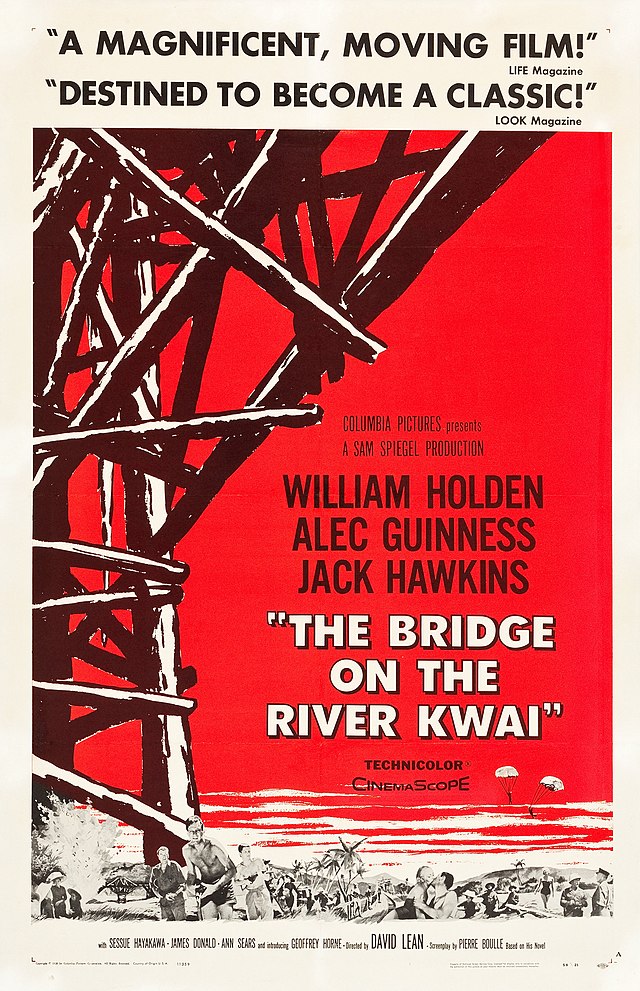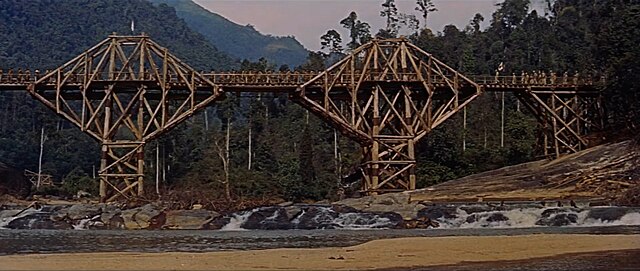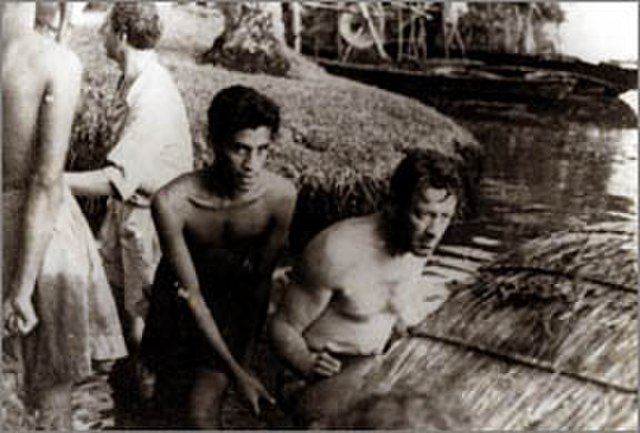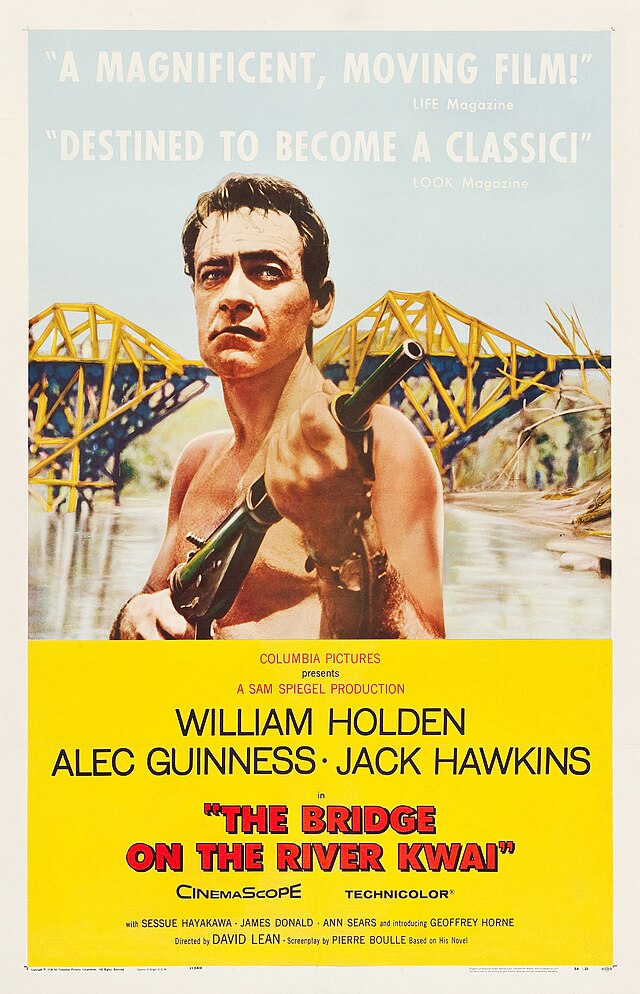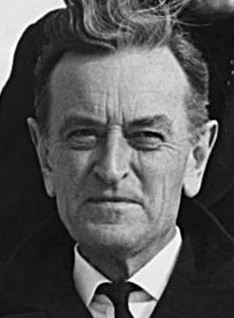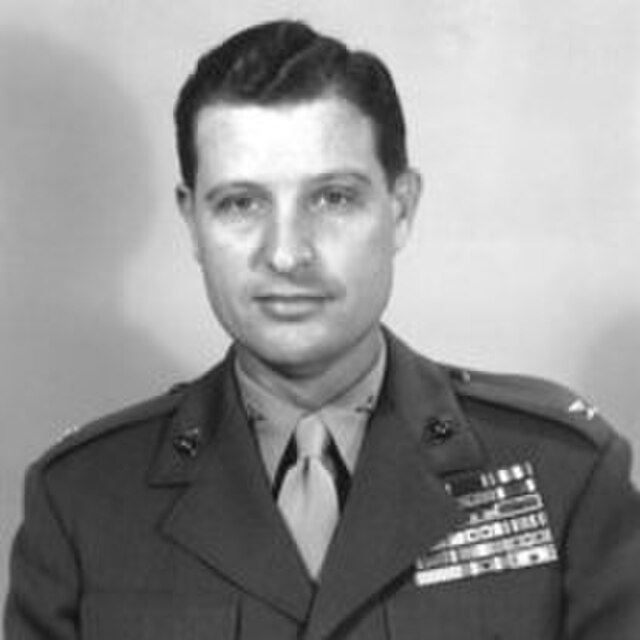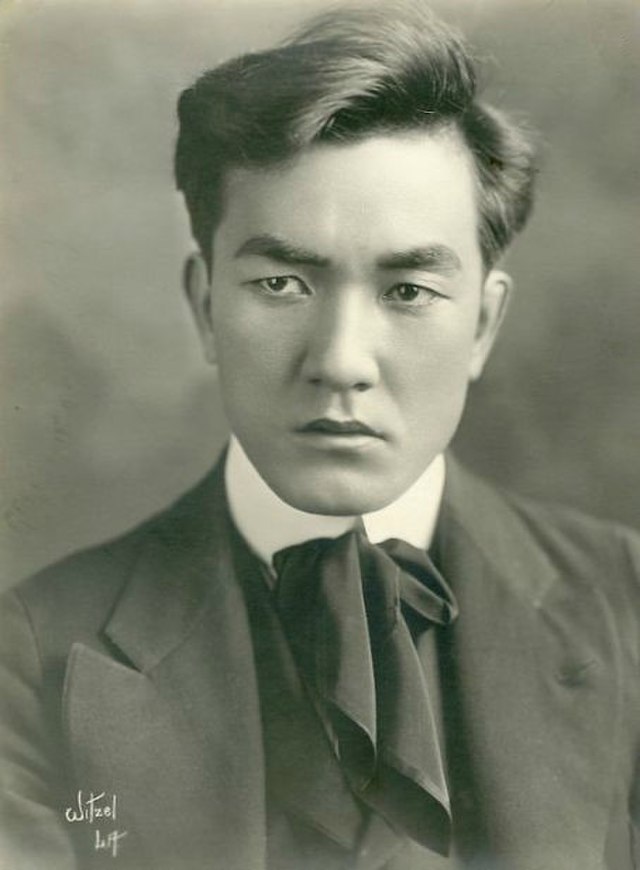The Bridge on the River Kwai - 1957
back| Released by | Columbia Pictures |
| Director | David Lean |
| Producer | Sam Spiegel |
| Script | Carl Foreman and Michael Wilson (adapted from the novel by Pierre Boulle) |
| Cinematography | Jack Hildyard |
| Music by | Malcolm Arnold |
| Running time | 161 minutes |
| Film budget | $2.8 million |
| Box office sales | $30 million |
| Main cast | Alec Guinness - William Holden - Jack Hawkins - Sessue Hayakawa - James Donald |
The Bridge on the River Kwai
A Gripping Exploration of the Madness of War
This iconic war film is renowned for its epic storytelling, masterful direction by David Lean, and memorable performances by the cast, especially Alec Guinness, whose portrayal of Colonel Nicholson earned him an Academy Award.
The film is set during World War II and focuses on the construction of the Burma Railway, exploring themes of duty, honor, and the complexities of war.
Related
The Bridge on the River Kwai – 1957
Summary and Analysis
The Bridge on the River Kwai is a World War II epic set in a Japanese prisoner-of-war (POW) camp in Burma, where British soldiers are forced by their Japanese captors to build a bridge over the River Kwai. The film opens with the arrival of a new group of British prisoners led by Colonel Nicholson (Alec Guinness). The Japanese commandant of the camp, Colonel Saito (Sessue Hayakawa), demands that all the prisoners, including the officers, work on constructing the bridge, which will be part of a railway to support the Japanese war effort.
Colonel Nicholson, adhering strictly to the Geneva Conventions, refuses to allow his officers to do manual labor, leading to a tense standoff between him and Colonel Saito. Nicholson is subjected to solitary confinement and severe conditions, but he remains steadfast in his principles. Eventually, Saito, under pressure to complete the bridge on time, relents and agrees to Nicholson's terms, allowing the officers to oversee the work rather than participate directly.
Once he gains control over the project, Nicholson becomes obsessed with building the bridge to the highest standards. He sees it as a symbol of British ingenuity, discipline, and resilience. His men, though initially reluctant, become equally committed to the task, seeing the bridge as a way to maintain their morale and dignity under harsh conditions.
Meanwhile, Commander Shears (William Holden), an American who had escaped from the camp, is recruited by British forces to join a mission to destroy the bridge. Reluctantly returning to the jungle, Shears, along with British commandos led by Major Warden (Jack Hawkins), embarks on a perilous journey to sabotage the bridge before it can be used by the Japanese.
As the construction of the bridge nears completion, the commandos reach the site and prepare to demolish it. On the day of the bridge's grand opening, a train carrying Japanese dignitaries is set to cross it. However, Nicholson, who has become increasingly obsessed with the bridge as a monument to British prowess, discovers the explosives planted by the commandos. In a moment of realization and internal conflict, Nicholson tries to alert the Japanese but is ultimately mortally wounded.
In the final moments, as he lies dying, Nicholson collapses on the detonator, triggering the explosives. The bridge is destroyed, sending the train into the river below. The film ends with Major Clipton (James Donald), the camp's medical officer, observing the destruction and uttering the famous line, "Madness! Madness!" as he reflects on the futility and insanity of war.
The Bridge on the River Kwai is a complex exploration of war, leadership, and the thin line between duty and obsession. Directed by David Lean, the film is not just a war story but a profound commentary on human nature and the moral ambiguities that arise in extreme circumstances.
Themes of Duty and Honor:
The film is deeply concerned with the concepts of duty and honor, particularly through the character of Colonel Nicholson. Nicholson's rigid adherence to military protocol and his belief in maintaining the honor of his men, even in captivity, drives much of the film's narrative. However, his commitment to these ideals gradually warps into an obsession with building the bridge, which he comes to see as a testament to British superiority. This obsession blinds him to the fact that he is aiding the enemy's war effort, highlighting the dangerous potential for honorable intentions to become destructive.
Colonel Saito's Character:
Colonel Saito, the Japanese commandant, serves as a foil to Nicholson. While initially portrayed as a harsh and unforgiving leader, Saito is revealed to be under immense pressure to complete the bridge or face severe consequences from his superiors. His eventual concession to Nicholson's demands is not just a strategic retreat but also an acknowledgment of his own vulnerability. Saito's complex portrayal challenges the simplistic enemy-villain dynamic often seen in war films, offering a more nuanced view of the characters' motivations.
The Role of Commander Shears:
William Holden's character, Commander Shears, represents a counterpoint to Nicholson's rigid ideals. A pragmatic survivor, Shears is initially more concerned with his own survival than with abstract notions of duty. His reluctant return to the jungle to destroy the bridge reflects the broader conflict between self-preservation and the demands of war. Shears' journey underscores the human cost of war and the sacrifices that individuals are forced to make.
The Bridge as a Symbol:
The bridge itself is a powerful symbol within the film. To the British prisoners, it becomes a representation of their identity, resilience, and ability to retain their dignity in captivity. For Nicholson, the bridge transcends its military purpose, becoming a monument to British discipline and craftsmanship. However, this symbolic value ultimately leads to Nicholson's tragic downfall as he loses sight of the broader context of the war. The destruction of the bridge at the film's climax is not just a tactical victory but also a symbolic act that underscores the futility and madness of war.
Madness and Obsession:
The film's famous closing line, "Madness! Madness!" encapsulates the central theme of the narrative—the fine line between dedication and madness. Nicholson's descent into obsession illustrates how easily a sense of duty can be corrupted when it becomes disconnected from reality. His final moments of clarity, where he recognizes the consequences of his actions, come too late, highlighting the tragic nature of his character.
Cinematic Excellence:
David Lean's direction is masterful, using the expansive landscapes and meticulous pacing to create a sense of both grandeur and claustrophobia. The cinematography by Jack Hildyard captures the lush beauty of the jungle, contrasting it with the brutality of the prisoners' situation. The film's score, composed by Malcolm Arnold, particularly the iconic "Colonel Bogey March," adds to the tension and underscores the ironic tone of the narrative.
In conclusion, The Bridge on the River Kwai is a richly layered film that goes beyond its historical setting to explore universal themes of human nature, leadership, and the moral complexities of war. It remains a powerful and thought-provoking work, recognized as one of the greatest films of all time.
Classic Trailer from The Bridge on the River Kwai:
Main Cast:
- Alec Guinness as Colonel Nicholson
- William Holden as Commander Shears
- Jack Hawkins as Major Warden
- Sessue Hayakawa as Colonel Saito
- James Donald as Major Clipton
- Geoffrey Horne as Lieutenant Joyce
- André Morell as Colonel Green
- Peter Williams as Captain Reeves
- John Boxer as Major Hughes
- Percy Herbert as Private Grogan
- Harold Goodwin as Private Baker
Supporting Cast:
- Ann Sears as Nurse (in hospital scenes with Shears)
- Heihachiro Okawa as Captain Kanematsu
- Keiichirô Katsumoto as Lieutenant Miura
- M.R.B. Chakrabandhu as Yai (the Siamese guide)
- Vilaiwan Seeboonreaung as Siamese Woman
Epic filmmaking of David Lean:
David Lean's direction in The Bridge on the River Kwai is a masterclass in epic filmmaking, demonstrating his remarkable ability to blend grand scale with deep character study. The film, which stands as one of the most iconic war movies of all time, is a testament to Lean's meticulous attention to detail, his skillful use of cinematic techniques, and his capacity to draw out powerful performances from his cast.
Visual Grandeur and Cinematic Scope: Lean was known for his ability to create sweeping, visually stunning films, and The Bridge on the River Kwai is no exception. Filmed on location in Ceylon (modern-day Sri Lanka), the movie makes extensive use of the natural landscape, with the lush jungles and the serene river providing a stark contrast to the harshness of the POW camp and the brutal labor involved in building the bridge. Lean's use of wide shots emphasizes the vastness and isolation of the setting, reinforcing the sense of the prisoners' entrapment and the enormity of their task.
The construction of the bridge itself is portrayed with a meticulousness that mirrors Colonel Nicholson's obsession with the project. Lean captures the progress of the bridge with a documentary-like precision, allowing the audience to see the effort and engineering that goes into it. This attention to detail not only serves to heighten the realism of the film but also underscores the tragic irony of the prisoners' labor—building a structure that will ultimately serve their enemies.
Character-Driven Narrative: While The Bridge on the River Kwai is visually grand, Lean never loses sight of the human story at its core. The film is as much about the psychological battle between Colonel Nicholson and Colonel Saito as it is about the physical construction of the bridge. Lean expertly builds tension between these two characters, using their confrontations to explore themes of honor, duty, and pride.
Alec Guinness's portrayal of Colonel Nicholson is shaped by Lean's direction, which carefully balances the character's rigidity and growing obsession. Lean allows the audience to sympathize with Nicholson's desire to maintain discipline and morale among his men, even as he gradually leads them toward a morally ambiguous end. This nuanced character development is a hallmark of Lean's direction, which often focuses on the internal conflicts of his protagonists.
Similarly, Lean elicits a complex performance from Sessue Hayakawa as Colonel Saito. Instead of being a one-dimensional antagonist, Saito is depicted as a man under immense pressure, whose initial cruelty is motivated by his own fear of failure. Lean's direction ensures that the audience sees Saito's vulnerability, adding layers to the character and avoiding simplistic portrayals of good and evil.
Pacing and Tension: Lean's control over pacing is another significant aspect of his direction. The film unfolds at a deliberate pace, allowing the audience to become fully immersed in the setting and the characters' struggles. This slower pace serves to build tension, as the stakes of the bridge's construction become increasingly clear. The methodical approach to storytelling reflects the slow, grinding nature of the prisoners' work, making the final moments of the film all the more impactful.
The climax of the film—where the bridge is destroyed just as the train crosses it—is a brilliant example of Lean's ability to craft suspense. The sequence is edited with precision, cutting between the commandos setting the explosives, the train approaching, and Nicholson's realization of what is happening. Lean expertly manipulates the tension, drawing out the moment until the final, explosive payoff. The destruction of the bridge, captured in real time, is both a spectacular cinematic achievement and a powerful thematic resolution.
Thematic Exploration: Lean's direction also deeply explores the themes of obsession, madness, and the futility of war. The film's famous closing line, "Madness! Madness!" spoken by Major Clipton, is not just a comment on Nicholson's actions but a reflection on the broader absurdity of war itself. Lean uses the bridge as a symbol of this madness—built with pride and destroyed in an instant, it represents the senseless cycles of creation and destruction that define war.
Lean’s direction ensures that these themes resonate throughout the film. The portrayal of the POW camp, the interactions between captors and captives, and the personal journeys of the characters all contribute to a broader commentary on the human cost of war. Lean’s ability to weave these themes into a visually and narratively compelling story is what makes The Bridge on the River Kwai not just a great war film, but a profound cinematic experience.
Legacy and Influence: David Lean's direction in The Bridge on the River Kwai has had a lasting influence on cinema. His ability to balance epic scope with intimate character study set a new standard for the war film genre. The film’s success, both critically and commercially, cemented Lean’s reputation as one of the greatest filmmakers of his time, paving the way for his subsequent epics, including Lawrence of Arabia and Doctor Zhivago.
In summary, David Lean's direction in The Bridge on the River Kwai is a brilliant synthesis of visual grandeur, character complexity, and thematic depth. His meticulous approach to filmmaking, combined with his ability to convey profound ideas through powerful storytelling, makes this film a timeless masterpiece.
Alec Guinness’ Performance:
Alec Guinness's portrayal of Colonel Nicholson in The Bridge on the River Kwai is a tour de force that stands as one of the defining performances of his illustrious career. His role as the rigid, duty-bound British officer who becomes tragically obsessed with building a bridge for his Japanese captors is a masterclass in subtlety, nuance, and the art of character development.
Transformation into Colonel Nicholson: Guinness's transformation into Colonel Nicholson is seamless, embodying the stiff-upper-lip mentality and unyielding discipline that characterized many British officers of the era. From his first appearance on screen, Guinness exudes a calm, almost serene confidence that belies the harsh conditions of the POW camp. His posture, gait, and precise speech reflect a man who is deeply committed to his principles and the well-being of his men, even in the face of adversity.
Subtlety in Expression: One of the most remarkable aspects of Guinness's performance is his ability to convey a wide range of emotions through subtle facial expressions and body language. Nicholson is a man of few outward displays of emotion, but Guinness skillfully uses small gestures—a raised eyebrow, a slight smile, or a tightened jaw—to communicate the inner turmoil and conviction that drive the character. This restraint makes Nicholson's moments of passion and frustration all the more powerful, as they emerge from a carefully controlled exterior.
Standoff with Colonel Saito: The early standoff between Nicholson and Colonel Saito (played by Sessue Hayakawa) is a pivotal moment in the film, and Guinness’s performance here is particularly striking. As Nicholson refuses to submit to Saito's demands that British officers participate in manual labor, Guinness portrays a man who is unwavering in his adherence to military protocol, even at great personal cost. His calm defiance, even under the threat of death, is a testament to the strength of Nicholson’s character, and Guinness captures this with a quiet but intense resolve.
As Nicholson endures solitary confinement in the "oven" as punishment, Guinness portrays his suffering with remarkable restraint. Rather than overplaying the physical discomfort, he focuses on the mental and emotional fortitude that Nicholson summons to survive. This subtlety adds depth to the character, showing that Nicholson's strength lies not just in his physical endurance, but in his unbreakable spirit.
Obsession with the Bridge: As the film progresses, Nicholson's dedication to building the bridge transforms into an all-consuming obsession, and it is here that Guinness's performance truly shines. He masterfully navigates this shift, gradually revealing the character’s descent into a kind of madness that is driven by pride and a distorted sense of duty.
Guinness portrays Nicholson’s growing obsession with a mix of enthusiasm and fervor, showing how the bridge, initially a means of maintaining order and discipline among his men, becomes a symbol of British ingenuity and honor. His speeches to his men, urging them to see the bridge as a monument to their resilience, are delivered with a passionate conviction that is both inspiring and unsettling. Guinness ensures that while Nicholson’s motives are understandable, they are also increasingly detached from reality, making the character’s eventual realization of his folly all the more tragic.
Internal Conflict and Tragic Realization: The climax of Guinness's performance comes in the final scenes, as Nicholson comes to the horrifying realization that his efforts have aided the enemy. In these moments, Guinness brilliantly conveys the internal conflict and dawning awareness that Nicholson experiences. His facial expressions and body language shift from pride to confusion, and finally to despair, as he recognizes the futility and betrayal inherent in his actions.
Guinness’s ability to communicate this emotional journey without the need for overt dramatics is a testament to his skill as an actor. When Nicholson, fatally wounded, collapses on the detonator and triggers the explosives that destroy the bridge, Guinness’s portrayal of his last moments—filled with a mixture of regret, horror, and perhaps a sense of relief—serves as a powerful conclusion to a complex character arc.
Balancing Heroism and Flaws: One of the greatest strengths of Guinness's performance is his ability to balance Nicholson's heroic qualities with his tragic flaws. The character is undeniably admirable in his commitment to his men and his principles, but Guinness ensures that the audience also sees the dangers of Nicholson's inflexibility and pride. This nuanced portrayal prevents Nicholson from becoming a mere caricature of the "stiff-upper-lip" British officer and instead presents him as a deeply human figure—noble, flawed, and ultimately tragic.
Recognition and Legacy: Alec Guinness's portrayal of Colonel Nicholson earned him widespread acclaim, culminating in the Academy Award for Best Actor. His performance is often cited as one of the greatest in film history, not just for its technical precision but for the depth of character it brings to the screen. Guinness's work in The Bridge on the River Kwai remains a benchmark for actors portraying complex, multifaceted characters in cinema.
In conclusion, Alec Guinness's performance in The Bridge on the River Kwai is a masterful study of character and subtlety. Through his portrayal of Colonel Nicholson, Guinness explores the fine line between duty and obsession, creating a character that is both deeply admirable and tragically flawed. His nuanced, restrained approach to the role ensures that Nicholson's journey is as compelling as it is heartbreaking, leaving a lasting impact on audiences and solidifying Guinness's place as one of the greatest actors of his generation.
Memorable Quotes from the Movie:
Colonel Nicholson:
"What have I done?"
This quote is uttered by Colonel Nicholson (Alec Guinness) in the film's climax when he realizes the full extent of his actions in aiding the enemy. It's a moment of tragic self-awareness and regret.
Colonel Nicholson:
"There are times when men have to be able to think about the greater good."
Nicholson says this to justify his decision to build the bridge, believing that it will serve as a testament to British discipline and ingenuity, even though it ultimately serves the Japanese war effort.
Major Clipton:
"Madness! Madness!"
This is perhaps the most famous quote from the film, spoken by Major Clipton (James Donald) in the final scene as he witnesses the destruction of the bridge and the chaos that ensues. It encapsulates the film's central theme of the absurdity and futility of war.
Colonel Saito:
"Do not speak to me of rules. This is war! This is not a game of cricket!"
Colonel Saito (Sessue Hayakawa) expresses his frustration with Colonel Nicholson's insistence on adhering to the rules of the Geneva Convention, highlighting the cultural and ideological clash between the two men.
Colonel Nicholson:
"One day the war will be over. I hope that the people who use this bridge in years to come will remember how it was built and who built it. Not a gang of slaves, but soldiers! British soldiers, Clipton! Even in captivity."
Nicholson's pride in the work his men have done is evident here. He sees the bridge as a monument to British resolve and discipline, even under the most trying circumstances.
Commander Shears:
"You mean, you intend to uphold the letter of the law, no matter what it costs? You won't work with the officers, but you've got no objections to working with the men? If that's the case, you could argue that there's no need for officers at all. After all, what's a soldier without a leader?"
Shears (William Holden) challenges Nicholson’s rigid adherence to rules, questioning the practical value of such strictness in the context of their dire situation.
Colonel Nicholson:
"The fact is, what we're doing could be construed as – forgive me, sir – collaboration with the enemy. Perhaps even as treasonable activity."
This line reflects the moral ambiguity that Nicholson is wrestling with as he becomes increasingly invested in the bridge project, despite its implications.
Classic Scenes from The Bridge on the River Kwai:
The Opening March:
- Scene Description: The film begins with a column of British POWs marching into the Japanese camp while whistling the "Colonel Bogey March." This scene immediately establishes the disciplined, unbroken spirit of the British soldiers, despite their dire circumstances.
- Significance: The march is one of the most recognizable moments in the film and has become an enduring symbol of the film's themes of resilience and camaraderie. The whistling of the "Colonel Bogey March" became iconic, symbolizing defiance and morale in the face of adversity.
Colonel Nicholson's Stand-Off with Colonel Saito:
- Scene Description: Early in the film, Colonel Nicholson (Alec Guinness) confronts Colonel Saito (Sessue Hayakawa) over the latter's demand that British officers participate in manual labor, which violates the Geneva Convention. Nicholson's refusal leads to a tense standoff that results in Nicholson being confined to "the oven" (a small, cramped iron box) under the scorching sun.
- Significance: This scene is pivotal in establishing Nicholson’s character as a man of principle and unyielding discipline. His calm defiance in the face of Saito’s threats is a defining moment that sets the tone for the rest of the film. It also underscores the cultural and ideological clash between the British and Japanese approaches to military discipline.
Nicholson's Release and the Decision to Build the Bridge:
- Scene Description: After enduring harsh treatment, Colonel Nicholson is eventually released by Colonel Saito. Instead of resenting his captors, Nicholson decides to take over the construction of the bridge, seeing it as a way to maintain order, discipline, and morale among his men.
- Significance: This scene marks a turning point in the film, where Nicholson’s sense of duty begins to morph into an obsession. Alec Guinness's performance here is nuanced, as he conveys both the relief of victory over Saito and the troubling beginnings of his fixation on the bridge as a symbol of British pride.
The Construction Montage:
- Scene Description: The film features a powerful montage of the bridge being constructed under Nicholson’s supervision. The montage shows the British soldiers working diligently, guided by Nicholson's unwavering leadership.
- Significance: The construction montage is significant because it visually represents the shifting focus of Nicholson’s motivations—from survival and dignity to an unhealthy obsession with completing the bridge. The montage also serves to heighten the irony of the situation: the POWs are working with incredible dedication on a project that will ultimately aid their enemy.
Commander Shears' Return to the Jungle:
- Scene Description: Commander Shears (William Holden), who had previously escaped the POW camp, is reluctantly recruited by the British forces to join a mission to destroy the bridge. His journey back through the jungle, filled with danger and physical hardship, is a tense and gripping sequence.
- Significance: This scene adds a layer of complexity to the narrative by introducing a parallel story of sabotage. It also deepens Shears' character, highlighting his inner conflict and the theme of reluctant heroism. The jungle scenes are a testament to David Lean’s ability to create suspense and atmosphere.
The Final Confrontation and Bridge Explosion:
- Scene Description: The climax of the film occurs when the commandos, including Shears, set explosives to destroy the bridge just as a Japanese train carrying important officials is about to cross it. Colonel Nicholson, realizing the sabotage at the last moment, struggles with the moral implications of his actions. Mortally wounded, he collapses on the detonator, triggering the explosion that destroys the bridge and sends the train into the river.
- Significance: This scene is the culmination of the film's central themes—duty, obsession, and the madness of war. Nicholson’s tragic realization of what he has done ("What have I done?") just before he falls onto the detonator is one of the most powerful moments in cinema. The explosion itself is a spectacular cinematic achievement, shot in real time, and remains one of the most memorable moments in film history.
Major Clipton’s Closing Words:
- Scene Description: After the bridge is destroyed, Major Clipton (James Donald) surveys the devastation and utters the famous line, "Madness! Madness!"
- Significance: Clipton’s words serve as a succinct and poignant summation of the film's exploration of the absurdity and futility of war. His observation leaves the audience with a powerful reflection on the tragic consequences of blind obsession and misplaced ideals.
Nicholson's Moment of Realization:
- Scene Description: Just before the bridge's destruction, Nicholson discovers the sabotage and realizes that his work has ultimately served the enemy. This moment of recognition is one of the most poignant in the film, as Nicholson’s pride and sense of accomplishment crumble before him.
- Significance: This scene is crucial as it encapsulates the tragedy of Nicholson's character arc. Alec Guinness’s performance here is deeply moving, as he conveys the shock, confusion, and regret that consume Nicholson in his final moments. It’s a powerful commentary on the dangers of letting duty and pride cloud moral judgment.
The Bridge on the River Kwai Bridge:
The song most commonly associated with The Bridge on the River Kwai is the "Colonel Bogey March," which plays a significant role in the film's soundtrack and has become almost synonymous with the movie itself.
About the "Colonel Bogey March":
- Origin: The "Colonel Bogey March" was composed in 1914 by British Army bandmaster Lieutenant F. J. Ricketts, who wrote under the pseudonym Kenneth J. Alford. The tune became popular in British military culture, often played by military bands during parades and marches.
- In the Film: In The Bridge on the River Kwai, the "Colonel Bogey March" is famously whistled by the British POWs as they march into the Japanese prison camp at the beginning of the film. This scene immediately establishes the resilient, defiant spirit of the soldiers, despite their dire situation. The upbeat and recognizable melody contrasts sharply with the grim realities of the POW camp, symbolizing the soldiers' determination to maintain their dignity and morale.
- Significance: The use of the "Colonel Bogey March" in the film was a brilliant choice by director David Lean, as it served multiple purposes. It not only highlighted the British soldiers' camaraderie and stoicism but also added a layer of irony, given the harsh conditions and the task they were forced to undertake. The whistling of the tune became iconic and is one of the most memorable aspects of the film.
- Adaptation: The song was adapted and incorporated into the film's score by composer Malcolm Arnold, who created a counter-melody to complement the "Colonel Bogey March." This combination of the familiar march with Arnold's original music helped reinforce the film's themes and added to its dramatic impact.
- Cultural Impact: The "Colonel Bogey March" gained widespread recognition following the film's release and has since been associated with themes of resilience and defiance. The tune has appeared in various other media and is often used to evoke a sense of Britishness or military pride.
Awards and Recognition:
Academy Awards (Oscars) - 1958:
The film was a major success at the Academy Awards, winning 7 out of its 8 nominations.
- Won: Best Picture
- Producers: Sam Spiegel
- Won: Best Director
- David Lean
- Won: Best Actor in a Leading Role
- Alec Guinness
- Won: Best Writing, Screenplay Based on Material from Another Medium
- Pierre Boulle (credited), Carl Foreman, Michael Wilson (posthumously awarded in 1985)
- Won: Best Cinematography
- Jack Hildyard
- Won: Best Film Editing
- Peter Taylor
- Won: Best Music, Scoring
- Malcolm Arnold
- Nominated: Best Actor in a Supporting Role
- Sessue Hayakawa
Golden Globe Awards - 1958:
The film also performed well at the Golden Globe Awards.
- Won: Best Motion Picture – Drama
- Won: Best Director – Motion Picture
- David Lean
- Won: Best Actor in a Motion Picture – Drama
- Alec Guinness
- Nominated: Best Supporting Actor
- Sessue Hayakawa
BAFTA Awards - 1958:
The film received several nominations at the British Academy of Film and Television Arts (BAFTA) Awards.
- Won: Best British Actor
- Alec Guinness
- Nominated: Best Film from Any Source
- Nominated: Best British Film
- Nominated: Best British Screenplay
- Michael Wilson, Carl Foreman
- Nominated: Best British Cinematography (Black and White)
- Jack Hildyard
Directors Guild of America (DGA) Awards - 1958:
- Won: Outstanding Directorial Achievement in Motion Pictures
- David Lean
Writers Guild of America (WGA) Awards - 1958:
- Won: Best Written American Drama
- Michael Wilson, Carl Foreman
New York Film Critics Circle Awards - 1957:
- Won: Best Film
- Won: Best Director
- David Lean
- Won: Best Actor
- Alec Guinness
National Board of Review - 1957:
- Won: Top Ten Films
- Won: Best Director
- David Lean
- Won: Best Actor
- Alec Guinness
Grammy Awards - 1959:
- Won: Best Soundtrack Album, Dramatic Picture Score or Original Cast
- Malcolm Arnold
Cannes Film Festival - 1957:
- Won: Special Mention for David Lean
Other Notable Awards:
- David di Donatello Awards (Italy) - 1958:
- Won: Best Foreign Production
- Jussi Awards (Finland) - 1959:
- Won: Best Foreign Actor
- Alec Guinness
- Won: Best Foreign Actor
- Laurel Awards - 1958:
- Won: Top Male Dramatic Performance
- Alec Guinness
- Won: Top Male Dramatic Performance
National Film Registry:
- Inducted: 1997
- Selected for preservation by the United States National Film Registry for being "culturally, historically, or aesthetically significant."

